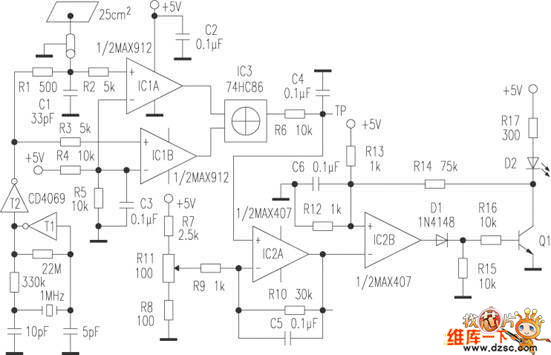
Touch On Switch Circuit

This touch-on switch can be activated through electrical means and can only be reset using a mechanical switch. When the touch terminal is activated by a finger, the SCR turns on and illuminates LED1.
The circuit utilizes a silicon-controlled rectifier (SCR) as the primary switching element, which is a semiconductor device that can control current flow. The touch terminal is designed to detect the presence of a finger, which provides a capacitive or resistive touch sensing capability. When the finger makes contact with the touch terminal, a small current is generated, which triggers the gate of the SCR, allowing it to conduct and complete the circuit.
The illumination of LED1 indicates that the SCR is in a conductive state, confirming that the switch has been activated. The LED serves not only as an indicator but also provides visual feedback to the user.
To reset the circuit, a mechanical switch is incorporated. This switch is connected in such a way that it interrupts the current flow to the SCR, allowing it to turn off. The design ensures that the SCR remains latched in its conductive state until the mechanical switch is engaged, providing a reliable method of control.
This touch-on switch circuit is suitable for applications where a non-mechanical activation is desired, such as in touch-sensitive lighting systems or user interfaces. The combination of touch activation and mechanical reset offers a unique approach to user interaction, enhancing the overall functionality of the device. This touch on-only switch can be triggered into conduction by electrical means, and can only be reset by way of a mechanical switch. When the touch terminal is contacted by a finger, the SCR turns on and illuminates LED1.
The circuit utilizes a silicon-controlled rectifier (SCR) as the primary switching element, which is a semiconductor device that can control current flow. The touch terminal is designed to detect the presence of a finger, which provides a capacitive or resistive touch sensing capability. When the finger makes contact with the touch terminal, a small current is generated, which triggers the gate of the SCR, allowing it to conduct and complete the circuit.
The illumination of LED1 indicates that the SCR is in a conductive state, confirming that the switch has been activated. The LED serves not only as an indicator but also provides visual feedback to the user.
To reset the circuit, a mechanical switch is incorporated. This switch is connected in such a way that it interrupts the current flow to the SCR, allowing it to turn off. The design ensures that the SCR remains latched in its conductive state until the mechanical switch is engaged, providing a reliable method of control.
This touch-on switch circuit is suitable for applications where a non-mechanical activation is desired, such as in touch-sensitive lighting systems or user interfaces. The combination of touch activation and mechanical reset offers a unique approach to user interaction, enhancing the overall functionality of the device. This touch on-only switch can be triggered into conduction by electrical means, and can only be reset by way of a mechanical switch. When the touch terminal is contacted by a finger, the SCR turns on and illuminates LED1.





